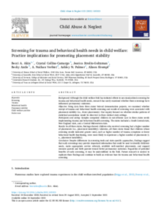Background
Although the child welfare field has initiated efforts to use standardized screening for trauma and behavioral health needs, research has rarely examined whether these screenings have influenced permanency outcomes.
Objective
Using data from three states' federal demonstration projects, we examined whether receipt of trauma and behavioral health screening and results of screening were associated with placement stability (i.e., fewer placements). Our inquiry focused on whether similar patterns of statistical associations would be observed in three distinct state settings.
Participants and setting
Samples comprised children in out-of-home care in three states newly implementing trauma and behavioral health screening. The states included a South Central state, New England state, and a Central Midwestern state.
Results
In all three states, findings showed children who received screening had a higher number of placements (i.e., placement instability). Likewise, all three states found that children whose screening results indicated greater need, such as higher number of trauma symptoms or lower behavioral health functioning, were more likely to experience a higher number of placements (i.e., placement instability).
Conclusion
Despite differences in screening tools and state-specific approaches, findings suggest that early screenings may provide important information that could be used to identify children's needs, make appropriate service referrals, establish well-matched placements, and support resource parents and birth parents toward better permanency outcomes. Regardless of potential benefits of early screening, it may be underutilized in the field. Future research is needed to replicate these findings and continue to build an evidence base for trauma and behavioral health screening.

